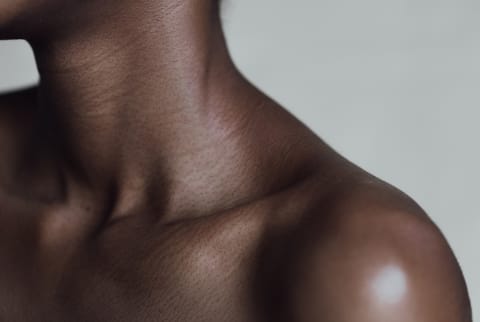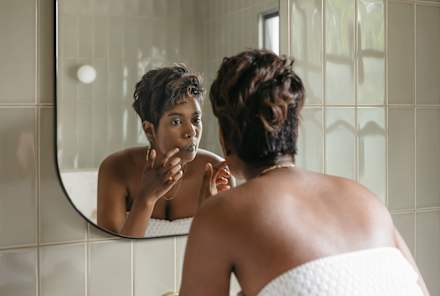Advertisement
Fungal Acne: What Is It, What Causes It & How To Get Rid Of Those Pesky Bumps


Let's face it, acne breakouts can be a challenge. Even though there are dozens of lotions, creams, cleansers, and spot treatments, it can often seem like nothing will actually prevent those breakouts from popping up again. If you've purchased every product humanly possible to treat acne breakouts on your body with no success, you may be suffering from fungal acne. And the funny thing is, fungal acne isn't actually acne at all but is commonly misdiagnosed and mistreated as such.
To help clear up the confusion, we tapped two board-certified dermatologists to break down all the details of fungal acne, including how you get it and how to treat it.
What is fungal acne?
Hilariously, fungal acne isn't actually an acne condition. The scientific term for what we consider fungal acne is Pityrosporum or Malassezia folliculitis. But since that's nearly impossible to say (and spell) for those of us outside of the medical profession, we'll refer to this condition as fungal acne for easier understanding.
Board-certified dermatologist Hadley King, M.D., explains that fungal acne is actually caused by yeast that inflames the hair follicle in the skin and causes pimple-like bumps to appear. According to King, it's normal for this type of yeast to live on the skin, but when it is not controlled, it can lead to breakouts. When yeast flourishes uncontrollably, it promotes inflammation and results in bumps on the skin.
What causes fungal acne?
The causes of fungal acne can vary, but board-certified dermatologist and founder of MMSkincare Ellen Marmur, M.D., says it's common for people to get fungal acne after being placed on antibiotics prescribed for treating acne. "When the antibiotics suppress bacteria, the yeast can overgrow," she says. Warm, humid climates, excessive sweat, and tight, non-breathable clothing are known to be causes, too. (Yes, leaving on your favorite fitness outfit for too long post-workout can be the culprit of these pesky breakouts.)
The problem occurs when the bacteria and yeast on the skin become imbalanced. Where there is imbalance, yeast continues to grow unchecked and can eventually result in acne-like bumps. Marmur also notes that people with a decreased immunity, such as those diagnosed with HIV or diabetes, are more prone to developing this condition.
How can you tell if you have fungal acne?
Unlike typical acne caused by bacteria, fungal acne is not typically found on the face. And according to King, that's one of the biggest visual differences when comparing fungal acne to other types of breakouts. "Fungal acne breakouts are more monomorphic, meaning they appear as uniform red bumps and small pustules on the chest, upper arms, and back but rarely involve the face," says King. "There are no whiteheads or blackheads, and the outbreaks are usually quite itchy."
In addition to itchy red pimples, other common characteristics of fungal acne are outbreaks located on oily areas of the body and appearing in clusters, as opposed to individual bumps.
How to treat fungal acne.
Treating fungal acne can vary depending on the severity of the condition. If you've checked all the boxes and your breakouts seem likely to be fungal acne, there are various at-home treatments to try before seeking help from an expert.
First, try identifying the possible cause of the fungal acne to prevent reoccurrence. King suggests showering and changing sweaty clothes immediately after workouts and opting for looser options that aren't snug to the skin. If the breakouts still persist, you can try over-the-counter products that can be applied topically to the infection. "Dandruff shampoos containing pyrithione zinc or selenium sulfide can be applied to the skin for five minutes and rinsed off," King suggests. "Or look for antifungal creams that contain econazole nitrate, ketoconazole, or clotrimazole, and apply it to the affected area twice daily."
If the breakouts still occur, King suggests booking an appointment with your dermatologist who can both confirm diagnosis and prescribe an oral antifungal medication. "Oral antifungal medications can often work faster because it penetrates more effectively into the follicle."
The bottom line.
If you're experiencing itchy, clustered breakouts on your body, put into place a proper hygiene regimen to help prevent and treat fungal acne. Don't leave on your workout clothes too long, properly cleanse your body after hot days, and remember, though spandex is cute, don't let it become your daily uniform. If all else fails and you're not sure where to go next, it's always a good idea to talk with your dermatologist for proper guidance.











